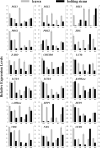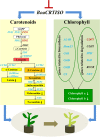Color-related chlorophyll and carotenoid concentrations of Chinese kale can be altered through CRISPR/Cas9 targeted editing of the carotenoid isomerase gene BoaCRTISO
- PMID: 33082968
- PMCID: PMC7527958
- DOI: 10.1038/s41438-020-00379-w
Color-related chlorophyll and carotenoid concentrations of Chinese kale can be altered through CRISPR/Cas9 targeted editing of the carotenoid isomerase gene BoaCRTISO
Abstract
The carotenoid isomerase gene (BoaCRTISO) of Chinese kale was targeted and edited using the CRISPR/Cas9 system in the present study. The results showed a high mutation rate (81.25%), and 13 crtiso mutants were obtained. Only two types of mutations, insertions and replacements, were found. Both the total and individual carotenoid and chlorophyll concentrations of the biallelic and homozygous mutants were reduced, and the total levels declined by 11.89-36.33%. The color of the biallelic and homozygous mutants changed from green to yellow, likely reflecting a reduction in the color-masking effect of chlorophyll on carotenoids. The expression levels of most carotenoid and chlorophyll biosynthesis-related genes, including CRTISO, were notably lower in the mutants than in the WT plants. In addition, the functional differences between members of this gene family were discussed. In summary, these findings indicate that CRISPR/Cas9 is a promising technique for the quality improvement of Chinese kale and other Brassica vegetables.
Keywords: Molecular engineering in plants; Secondary metabolism; Transgenic plants.
© The Author(s) 2020.
Conflict of interest statement
Conflict of interestThe authors declare that they have no conflict of interest.
Figures






Similar articles
-
Effects of sgRNAs, Promoters, and Explants on the Gene Editing Efficiency of the CRISPR/Cas9 System in Chinese Kale.Int J Mol Sci. 2023 Aug 26;24(17):13241. doi: 10.3390/ijms241713241. Int J Mol Sci. 2023. PMID: 37686051 Free PMC article.
-
Characterization of BoaCRTISO Reveals Its Role in Carotenoid Biosynthesis in Chinese Kale.Front Plant Sci. 2021 May 14;12:662684. doi: 10.3389/fpls.2021.662684. eCollection 2021. Front Plant Sci. 2021. PMID: 34054903 Free PMC article.
-
Characterization of the Role of the Neoxanthin Synthase Gene BoaNXS in Carotenoid Biosynthesis in Chinese Kale.Genes (Basel). 2021 Jul 24;12(8):1122. doi: 10.3390/genes12081122. Genes (Basel). 2021. PMID: 34440295 Free PMC article.
-
Site-Directed Mutagenesis of the Carotenoid Isomerase Gene BnaCRTISO Alters the Color of Petals and Leaves in Brassica napus L.Front Plant Sci. 2022 Feb 10;13:801456. doi: 10.3389/fpls.2022.801456. eCollection 2022. Front Plant Sci. 2022. PMID: 35222464 Free PMC article.
-
Simultaneous changes in anthocyanin, chlorophyll, and carotenoid contents produce green variegation in pink-leaved ornamental kale.BMC Genomics. 2021 Jun 17;22(1):455. doi: 10.1186/s12864-021-07785-x. BMC Genomics. 2021. PMID: 34139990 Free PMC article.
Cited by
-
Enhancement of violaxanthin accumulation in Nannochloropsis oceanica by overexpressing a carotenoid isomerase gene from Phaeodactylum tricornutum.Front Microbiol. 2022 Aug 31;13:942883. doi: 10.3389/fmicb.2022.942883. eCollection 2022. Front Microbiol. 2022. PMID: 36118188 Free PMC article.
-
Effects of sgRNAs, Promoters, and Explants on the Gene Editing Efficiency of the CRISPR/Cas9 System in Chinese Kale.Int J Mol Sci. 2023 Aug 26;24(17):13241. doi: 10.3390/ijms241713241. Int J Mol Sci. 2023. PMID: 37686051 Free PMC article.
-
An apple (Malus domestica) AP2/ERF transcription factor modulates carotenoid accumulation.Hortic Res. 2021 Oct 5;8(1):223. doi: 10.1038/s41438-021-00694-w. Hortic Res. 2021. PMID: 34611138 Free PMC article.
-
Enhanced pigment production from plants and microbes: a genome editing approach.3 Biotech. 2025 May;15(5):129. doi: 10.1007/s13205-025-04290-w. Epub 2025 Apr 16. 3 Biotech. 2025. PMID: 40255449 Review.
-
Genome Editing for Improving Crop Nutrition.Front Genome Ed. 2022 Feb 9;4:850104. doi: 10.3389/fgeed.2022.850104. eCollection 2022. Front Genome Ed. 2022. PMID: 35224538 Free PMC article. Review.
References
-
- Sun B, et al. Molecular cloning and expression analysis of the ζ-carotene desaturase gene in Chinese kale (Brassica oleracea var. alboglabra Bailey) Hortic. Plant J. 2018;4:94–102. doi: 10.1016/j.hpj.2018.03.005. - DOI
-
- Chen J, et al. Assessment of glucosinolates in Chinese kale by near-infrared spectroscopy. Int. J. Food Prop. 2014;17:1668–1679. doi: 10.1080/10942912.2012.678535. - DOI
-
- Sun B, Yan HZ, Liu N, Wei J, Wang QM. Effect of 1-MCP treatment on postharvest quality characters, antioxidants and glucosinolates of Chinese kale. Food Chem. 2012;131:519–526. doi: 10.1016/j.foodchem.2011.09.016. - DOI

